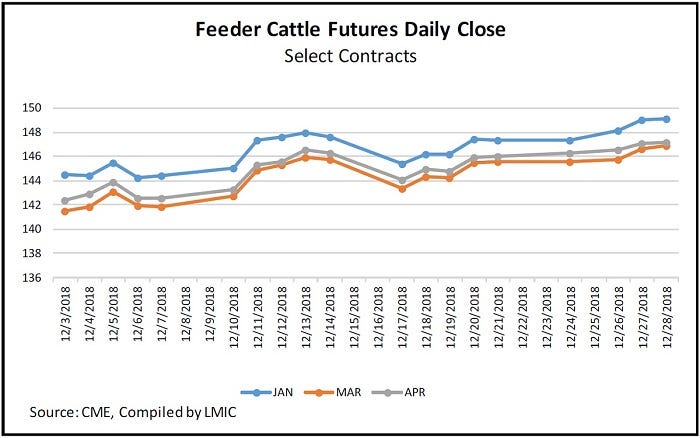
As the door closes on 2018 and a new one opens on 2019, there are reasons to be cautiously optimistic about cattle prices and markets.
Despite record or near-record beef production, domestic retail sales and exports have remained relatively good. Certainly they have slipped, but anyone who thought they wouldn't was foolishly optimistic.
The latest cattle on feed report showed feedlots are current on their marketings, so we shouldn't see any ugly surprises there. Further, a recent report from the CME Group noted despite slippage in the prices of 700- to 800-pound steers in the final quarter of the year, the futures markets have begun to move the opposite direction.
"January, March, and April's feeder cattle contracts closed last week on a high note, ending the week with the highest daily close values seen in the month of December," said the report. It further noted that since the Cattle on Feed report was released December 20, the January through April feeder futures contract have climbed $2.88 to $2.40 per hundredweight. This at least suggests some market optimism.

Of course, we seem to be mired in an ugly marketing situation for beef cows, likely due to the bloodbath in the dairy sector together with the fact we may be nearing the high point in cattle numbers in this cattle cycle. On the other hand, low prices for replacement cows and heifers can offer newcomers a cheaper entry point into the cow business.
Further, I hope the government shut-down won't keep us from getting a January 1 cattle report, since that's an important milestone for market analysis.
Most of all, I am hopeful for those who have abandoned the faulty paradigm of production per cow as the centerpiece for economic decisions. Each cow must produce, of course, but production per acre has a much bigger influence on ranch profitability. Better yet, it is net profit per acre and net profit per operation that should be our benchmarks for all future decisions.
We are trying to add more bloggers to our stable at Beef Producer, and not just bloggers but those who actually raise cattle profitably and offer valid ideas for how our readership can do the same.
Our industry likely will suffer more price erosion this year because of huge domestic meat supplies, and we could yet struggle with trade issues, disease outbreaks or a rumored financial reset or nationalization of the privately held Federal Reserve, but most of those still look like long shots to me.
Just remember the first word in profit for the cattle industry has long been cost control. It will continue to be so.
We wish you all the best this year.
About the Author(s)
You May Also Like




